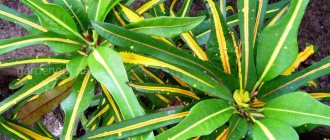There is real confusion in the minds of amateur flower growers with croton. They stubbornly call this a spectacular house plant, although in fact Croton grows in the wild or on tropical farms, where it is grown for medicinal purposes or to obtain seeds. And these are large trees or shrubs. In our houses it is not Croton that lives, but Codium. Moreover, only one species is the variegated codiaeum (Codiaeum variegatum) from the Euphorbiaceae family. In Europe it is often called "Joseph's cloak". There it became popular in the first half of the 19th century.
Codium variegated is an evergreen shrub that grows at home no more than 70 cm. Large (up to 30 cm) leathery leaves are arranged alternately on a straight branching trunk. The flowering is inconspicuous, the flowers are small, pale, the seeds are large. But the value of the plant is not in the flowers, but in the leaves - they have different shapes and incredibly beautiful colors: all shades of green, yellow, orange, red and even black! The decorative effect is enhanced by bright colored veins and spots (1).
There are at least 7 varieties of variegated codiaum, which differ in the shape of the leaf blade. For example, in the tortile form the leaf is heart-shaped with an elongated pointed tip, in trilobium the base of the leaf is deltoid, and the plate itself is divided into 3 parts.
Croton varieties
The popularity of this plant led to a lot of work by breeders who created original varieties and hybrids.
Excellent - its leaves are similar in appearance to oak leaves, the top is green with yellow veins, and the lower part of the leaf is red-burgundy.
Gold Star - graceful green leaves covered with numerous golden spots.
Missis Ayston is an elegant tree on which you can see leaves of cream, yellow and green at the same time.
Mummy - This variety has narrow, spiraling leaves that are orange-red in color with dark green stripes.
Petra is a compact bush up to 50 cm high with large green leaves with yellow veins.
Spirale is a very original variety with narrow bright leaves twisted around its axis.
Sunny star is a tree up to 80 cm high with thin yellow-green leaves.
Tamara is an elegant shrub up to 1 m high with white-cream-green leaves in the form of an elongated oval with a sharp tip and a wavy edge.
Zanziebare - distinguished by narrow long leaves of dark green color with yellow specks.
Zulu - with oddly shaped lance-shaped green leaves with yellow spots.
Photo and description of the Croton flower
Under natural conditions, codiaum grows on the Malaysian and Indian islands, in the forests of Southeast Asia and the Pacific Islands.
The kraton flower is different:
- leathery, asymmetrical, oblong-lanceolate, pointed, blunt-pointed, three-lobed, notched or broadly ovate leaves;
- up to three meters high;
- light yellow-green shades of young leaves and rich burgundy-green color of leaves of adult bushes;
- racemose axillary inflorescences with inconspicuous cream flowers;
- pronounced veins on the leaf blades.
It is difficult to confuse this plant with any other flowers.
Croton care at home
The homeland of croton (codiaum) is the tropical corners of India and Malaysia. And this determines its requirements for growing conditions.
“Many problems in growing codiaum can be avoided if you strictly observe the temperature regime,” says houseplant collector Elizaveta Starostina. – In summer, the plant is comfortable at a temperature of 20 - 25 ° C, in winter - not lower than 18 ° C. No temperature changes, cold window sills or drafts!
Photo: globallookpress.com
Priming
Of the ready-made mixtures, rose soil is most suitable for codiaum. However, experienced gardeners prefer to prepare the soil themselves. To do this, take leaf and garden humus, peat and coarse river sand in equal proportions. Add a glass of crushed wood soil and a handful of zeolite to 3 liters of the mixture. The reaction of the soil solution should be alkaline - 6 - 7.4 pH.
Lighting
This plant loves bright light, but does not tolerate direct sunlight - they “erase” the beautiful design and can even cause burns. The best place from spring to autumn is a window sill facing the east, west or southeast direction.
But in winter, the codiaum can be moved to a south-facing window sill. If the color of the leaves begins to fade, turn on the phytolamps!
Humidity
Codiaum loves moist soil and air. From April to October, watering is frequent and abundant up to 3 times a week. Make sure that the soil does not dry out more than 3 cm from the surface of the pot. In winter, one watering per week is enough. 30 minutes after watering, the water from the pan must be drained.
The plant responds very well to daily spraying and a humidifier. But this is not enough. Wipe the leaves on both sides daily with a soft, damp sponge - this increases humidity and removes dust and pests. Give your pet a warm shower once a month (2).
Water for irrigation and spraying should be settled, soft and warm - 2 - 4 °C above room temperature. Ideally use rain or filtered water.
Fertilizers
For codiaum, use complex mineral fertilizer for succulents and cacti. It is also recommended to use deciduous wood ash as fertilizer.
Feeding
Fertilizing is carried out only on moist soil, with solutions of complex mineral fertilizer. In spring and summer, take a full dose once every 3 weeks. In autumn and winter - 1/2 dose of fertilizer once every 1.5 months. Once every 2 months, add a teaspoon of wood ash to the pot and lightly loosen the top layer of soil.
Trimming
A beautiful crown and optimal size are formed by regular pruning. In young plants, shoots are pinched, in adults - pruning. The first pinching is done when the young plant reaches a height of 15 - 20 cm, then each shoot is cut to the outer bud as soon as it reaches 20 cm in length.
Photo: globallookpress.com
It is recommended to trim flower shoots and side shoots that protrude too much beyond the crown being formed.
When pinching the apical buds, the wounds become covered with milky sap; when cutting stems, it is recommended to powder the sections with crushed coal.
Pruning is carried out in the spring and, if necessary, in the summer. 2 - 3 days after pruning, the plants are watered and the crowns are sprayed with growth stimulants.
Important! The milky sap of the plant is poisonous, so carry out work only with gloves.
Landing
In order to properly plant croton, you first need to cut a cutting on which several internodes will be located. After this, it is very important to rinse the cut with a small amount of water. In this way, it is possible to destroy the film, which can prevent the rooting process of the cuttings.
- The cut cuttings will have to be planted in the soil, which should consist of sand and earth. In this case, it is important to compact the soil a little near the planted cuttings.
- It is very important to water the planted croton. To do this, water the young plant once every 5 days. In this case, settled water is used.
- A prerequisite for rooting cuttings is the construction of a mini-greenhouse. It is very easy to make from a plastic bag. After this, the plant is placed in the shade and fresh air is allowed inside every couple of days.
Location and lighting
Croton, unlike many other plants, loves bright sunlight very much. At the same time, its foliage does not lose its original color, but only becomes stronger.
It is recommended to place the flower pot on the windowsill, which is located on the south side. In hot weather, the flower will need to create a small shade. This will help avoid severe leaf burns.
The plant can also be placed on the east and west sides of the house in a special floor stand. The flower must be placed in such a way that natural light can illuminate the croton for as long as possible throughout the day.
With the onset of cold weather, fluorescent lamps and phyto-lamps can be used for lighting.
Pot sizes
The active growth of the plant will primarily depend on the condition of the root system of the flower. It is for this reason that the choice of a flower pot must be approached with great responsibility.
The best pot for croton can be a wide, but not too deep pot. This pot size will allow the roots of the plant to be positioned with maximum comfort for the flower. If you go too far with the size, then all the water that will be used for irrigation will go to the roots. Which in turn can cause root rot.
The pot should be as stable and practical as possible. Don't pay attention to clay pots. Their disadvantage is their heavy weight and the creation of some inconveniences for the growth of the flower. The best option in this situation would be a pot made of plastic.
The soil
When planting and replanting croton, the quality of the soil is very important. In order for the plant to grow comfortably at home, it is necessary to select loose and well-drained soil. At the same time, it must be breathable and have an average level of acidity. For croton it has an approximate pH of 6.1 to 6.5.
Preparing the soil for planting a flower is quite simple. To do this you will need turf soil, sheet soil and sand. All ingredients are mixed in a ratio of 1:2:1. Before planting a plant in the ground, the soil must be disinfected. To do this, you can pour a small amount of potassium permanganate solution on it. This will make it possible to avoid the appearance of flower parasites.
Croton propagation at home
Croton (codium) can be propagated by seeds, cuttings and layering.
Seeds. During seed propagation, parental characteristics may not be preserved.
The seeds must be fresh; they are poured with hot water (60 °C) for 30 minutes, then allowed to swell in the same water for 24 hours. Sow in bowls with a mixture of peat and sand to a depth of 1 cm. Cover with film and place in a warm place. Water the tray regularly.
When two true leaves appear, the seedlings are planted in pots.
By cuttings. There are two possible rooting options: in soil and water. The optimal time for cuttings is February-April. The cuttings are cut 10-15 cm long, the lower leaves are removed. The milky sap is washed off with warm water and the sections are allowed to dry for 3 hours. Then the lower cut is dusted with Kornevin. The cuttings are planted in a pot with loose soil (perlite and peat) and covered with a jar. Place in a warm place (24 °C). Spray every day and pour water into the tray as needed. The rooting process lasts approximately 1 month. Then the plants are planted in pots with codiaum soil.
Cuttings can also be rooted in a glass of water. However, it will be necessary to maintain an optimal water temperature of 22 - 24 °C. When roots grow 1.5 - 2 cm long, the cuttings are planted in the ground, placed under film for 2 - 3 days and then the soil moisture is carefully monitored (2).
– They often write about the method of rooting codiaum with leaves. And indeed, the leaf develops roots quite quickly. However, then the process stops, because a growth bud is necessary for the appearance of a new plant. Therefore, you need just a cutting, at least a small piece of a stem with a leaf,” explains houseplant collector Elizaveta Starostina.
By layering. For varieties with long shoots, you can use the method of propagation by layering. To do this, remove the bark from the bare part of the branch - in a ring 1 cm wide, apply moistened sphagnum moss to the wound, wrap it with stretch film, securing it at the top and bottom. In a month you will see how the roots have sprouted through the moss. The branch under them is cut off and planted in the ground.
Mistake #4. They forget that the milky juice of croton (codium) is poisonous
This plant is poisonous, i.e. must be kept in places inaccessible to children and pets.
Crotons in the winter garden
When forming the crown or preparing cuttings, it is better to work with gloves. After work, you need to thoroughly wash the containers in which the cuttings were located. It is better to use disposable cups for this purpose; they are then thrown away.
Croton transplant at home
It is advisable to replant young plants 2 times a year, plants older than 2 years - once every 2 years, large adults are not replanted, but only replace the top layer of soil annually.
Photo: globallookpress.com
The first transplant is 2 weeks after purchase. The pot should be 3 - 5 cm in diameter wider than the old one. 3 cm of drainage must be placed at the bottom. Starting from the second transplant, the plants are turned over, trying not to destroy the earthen coma, but only slightly shaking off the old soil. Damaged and diseased roots are cut off and powdered with crushed coal.
The best time to transplant is spring. Please note that you cannot replant a flowering plant and a diseased one (except for root rot disease).
Directory of indoor plants
Why prune croton? Read in today's article, when and how to prune croton at home? Additional procedures during pruning.
Croton pruning at home
Croton is a luxurious ornamental foliage plant from the Oceania region that loves balanced, measured care. Another fascinating name - codiaum - can be prepared for you in your search for a care technique. We will give as much information as possible about pruning and restoring the flower after.
If the croton's leaves dry out and fall off , the crown develops poorly, or other unpleasant symptoms arise, it will have to be pruned. Over time, croton blunts development. Stems and leaves that have not been renewed for a long time lose activity and become elongated. Pruning stimulates development.
Why trim croton at home:
- Form the top.
- Awaken the plant.
- Stimulate side shoots.
- Renew the plant.
- Treat damaged areas.
To trim croton at home you will need : a sharp knife, scissors or pruning shears, powdered charcoal or fungicide, alcohol, gloves.
Step-by-step pruning of croton at home:
- Process the croton pruning tool. Dry from any remaining alcohol.
- Choose a place on the plant - leave living tissue of the damaged shoot.
- Make an even, precise and quick cut without cutting the croton.
- Sprinkle the cut area with charcoal powder. Leave to dry.
- Do not spray or wet the cut area for a week after the procedure.
What can the croton pruning procedure be combined with : pinching, propagation. An adult, overgrown plant can be propagated by leaf cuttings, not disconnecting broken or damaged shoots, but healthy and strong ones. The young plant is simply pinched.
Length of shoots: 15-20 cm trimmings - grow 5 cm after the procedure.
What else to trim : flower buds, flower stalks.
Why: Croton spends a lot of energy maintaining buds, which in no way decorate the plant.
Croton (codiaum) pruning age: 5 years – full pruning; 2 years – part-time; 1.5 years – pinching.
Croton diseases
Anthracnose. It appears as gray or brown spots on the leaves. The cause is often excessive watering and stagnation of water in the root zone.
For protection, spray the plant three times and water the soil with any fungicide, for example Fitosporin or Alirin (3).
Root rot. The first signs of the disease are the leaves turning pale. And then they dry out and fall off.
The plant must be urgently replanted by removing soft and damaged roots and sprinkling the sections with crushed coal. Add two Glyocladin tablets to the top layer of soil. Spray the plant and water it with Alirin solution (3).
Mistake #2. Insufficient soil and air moisture
Codiaum (croton) does not tolerate even short-term drying out of the soil in the pot. In summer, it is watered abundantly, but without waterlogging the soil mixture in the planting container. In winter, watering is moderate, without drying out the surface layer of soil. In summer, the crown is sprayed daily; when the air temperature drops in winter, the leaves are wiped with a wet cloth or sponge.
Codiaum (croton) should be sprayed with soft water so that unsightly spots do not remain on the leaves.
When watering, use warm rather than cold water. The chlorinated one is defended.
Croton pests
Spider mite. These pests leave small punctures and whitish spots on the leaves.
As a preventive measure, regular spraying and wiping the leaves with a damp sponge has worked well. It is recommended to thoroughly wash the affected plant with a sponge and soapy water, then spray it three times with an interval of 7 days with Actellik or Fitoverm (3).
Shield. Insects are noticeable on leaves and stems - they look like brown dry plaques.
The plant should be wiped with a cotton pad soaked in vodka, then washed with a soap solution, adding an infusion of tobacco dust (1 tablespoon per 1 liter of boiling water, boil for 30 minutes, leave for 24 hours, then strain and add 1 tablespoon of liquid laundry soap) . It is also recommended to spray with Actellik (3).
Diseases and pests of codium
Any deviations from the rules for caring for Croton lead to illness.
The sun's rays cause leaf burns; to prevent the disease, it is enough to limit their exposure to the plant. Insufficient lighting leads to the loss of bright shades of leaves. If there is little light in the room, you need to provide an additional source. Excessive watering leads to rotting of the roots, and lack of moisture causes the leaves to dry out.
Therefore, it is important to maintain a balance of water procedures. Draft and temperature changes are your worst enemies. Croton drops leaves from them
The optimal temperature for a flower is 17-22 degrees. The milky sap attracts Spider Mites and Shield Aphids. They can lead to death if they are not eliminated in time.
Treatment with specialized insecticidal agents will help in pest control. At home, you can prepare a soap-tobacco solution and wipe the leaves and stems with it. 3 hours after the procedure, be sure to rinse the plant with clean warm water.
After interacting with the flower, you must wash your hands thoroughly with soap, as the sap of the plant is poisonous.
Frequently asked questions when growing croton
Beginning gardeners encounter various difficulties when growing croton. Proper plant care will help to avoid this.
Why does croton shed its leaves and what to do? Don’t worry that leaves sometimes fall off the croton. This is considered a completely natural process. If the plant sheds too many leaves, the cause may be improper watering, insufficiently humid air, or sudden temperature fluctuations. Nutritional deficiencies or spider mite attacks also lead to problems.
Why do the tips of croton leaves dry out? Dry leaves may be due to irregular watering or insufficiently humid air. To avoid such problems, you need to systematically moisten the soil and spray the leaves of the crop. It is worth considering that insufficient soil moisture provokes the appearance of parasites and other problems.
Why can't Croton be kept at home? Croton should not be kept in a house with pets. The plant has poisonous sap that can harm pets. It is worth considering that this liquid can cause severe skin irritation. Therefore, you should wear gloves when caring for the plant.
It is believed that croton is able to absorb negative energy. It is worth growing for those people who lack determination or want to always maintain a good mood.
Step-by-Step Guide: How to Pinch Croton
Codium is pinched to give the plant the desired shape and, in some cases, to preserve the color of the base leaves. Some species of this flower produce large numbers of young upper leaves of a nondescript color, while the owners prefer fleshy and bright large leaves on the sides of the trunk.
Often, pinching is carried out for the benefit of the croton itself, because when it outgrows, it can bend under its own weight or even turn over along with the pot.
Having decided to pinch, you need to decide on the growth point. Usually it is easy to find in the upper part of the flower, where small and thin young shoots and leaves hatch. After pinching, you need to be patient. Croton is a capricious plant. Having lost its growth point, it can freeze for a long time.
In order to avoid disappointment from an unaesthetic plant, you must follow the following pinching rules:
- For branching of a single trunk, you need to pinch the croton at a short distance from the ground.
- After pinching, the flower needs rest and careful care.
- You can pinch this plant only during the period of intensive growth, that is, in the spring.
Many amateur flower growers sometimes begin to panic due to the reluctance of their flower to grow in the right directions. But, you need to give the codiaum time. After some time at rest, he will gain new strength.
Trimming
It occurs only in mature plants that have reached 40-45 cm in height. The operation is simply necessary if the croton grows only one shoot that stretches upward. In this case, the flower does not look very lush, produces very few leaves at the bottom, and often has a half-bare stem. Pruning is carried out so that the codiaum begins to produce side branches and form into a nice bush with evenly growing leaves.
Trimming methods
A home flower can be pruned in any season, if necessary. But it is still better to carry out the operation in the spring, when the croton is developing in full force. A sharpened knife is wiped with alcohol or cologne and the top is carefully cut off to about 13-17 cm. It is advisable to make the cut straight and sprinkle it with wood ash for disinfection.











